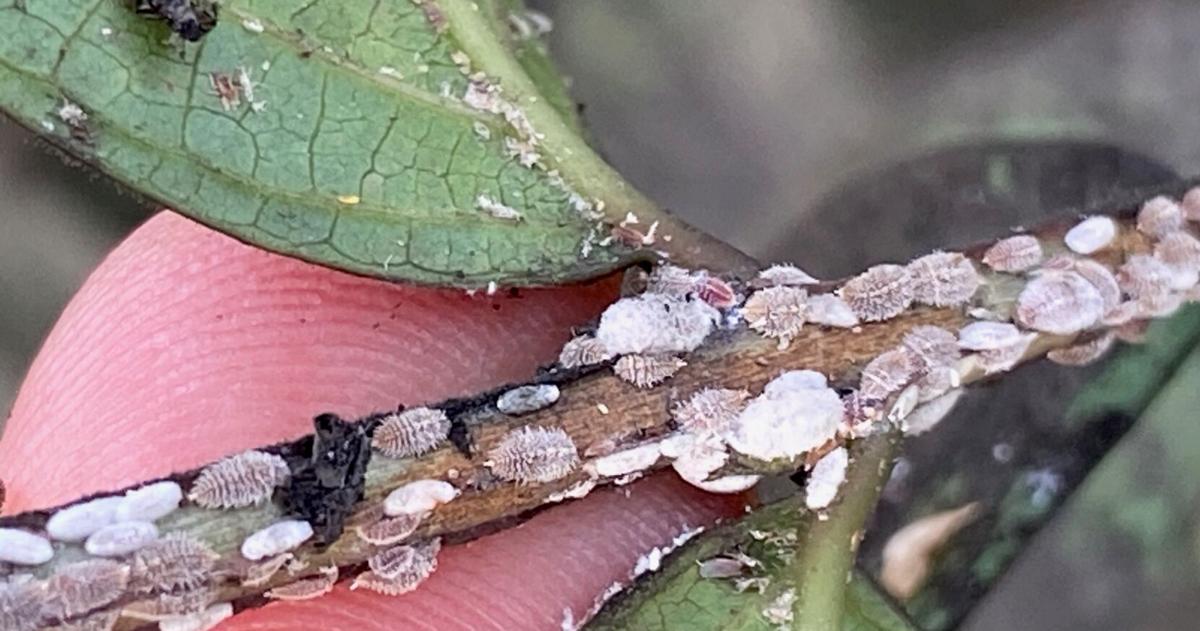There’s good news and bad news at Trident Technical College: we now have crape myrtle scale. The good news is horticulture students get firsthand exposure to this invasive pest. The bad news is we have crape myrtle scale.
If you’ve noticed your crape myrtles looking a little dirty, you’re not alone. Charleston’s favorite summer-flowering tree has come under attack in recent years. This insect looks more like drips of candle wax than a bug.
The first clue of infestation is a black coating that looks like your tree has been dusted with chimney soot. It’s a fungus called black sooty mold, and aside from looking unpleasant, it doesn’t harm the tree.
Scale insects have piercing-sucking mouthparts that tap into the plant’s vascular system. They draw out sap, which is mostly sugar water, but only consume a small fraction of what they take in. The majority passes through their bodies and drips out as a sticky residue we call honeydew.
Honeydew coats bark and leaves like a glazed donut. It’s rich in sugars, so fungi feast on it. Black sooty mold won’t kill your crape myrtle, but it’s not happy looking.
The troublemakers are clusters of small, white bumps. Crush one (gross) and you’ll find a pinkish ooze inside – the scale insect. They weaken trees by feeding on sap. They rarely kill a crape myrtle, but they cause stress for the tree that reduces flowering and can cause twig dieback.
Black sooty mold and a waxy substance covering the branches of your crape myrtle tree means a pest is taking over.
Crape myrtle scale only recently showed up in our area. Native to Asia, it first appeared in the U.S. in 2004 in Texas and has spread steadily eastward, usually hitching a ride on nursery stock where there’s no shortage of food.
The pest is just one example of a larger issue: invasive species. When insects, plants or animals arrive in a new region, they leave behind natural predators, parasites and micro-organisms that kept them in check back home. In their native environments, scale populations are managed by tiny wasps, fungi or diseases that knock them down before they get out of hand.
Here in Charleston, those natural enemies are either absent or too few to keep up. The lack of checks and balances allows invasive pests to spread quickly and reach damaging levels.
We’ve seen it before. Imported fire ants thrive here because our soils and climate suit them, and the South American organisms that once kept them balanced didn’t make the trip. Now their mounds rule the landscape.
The biggest obstacle to controlling scale insects is their armor. Their waxy coating makes them resistant to many insecticides. Add in the size of a mature crape myrtle and control gets complicated.
Scale control
The most effective tool is a soil-applied systemic insecticide. These products are absorbed by the roots and carried through the tree’s vascular system, reaching the insects wherever they’re feeding.
For homeowners, the most common option is imidacloprid, sold under various tree and shrub insect control brands. Apply as a soil drench in spring and the tree does the rest. Follow the label carefully. More is not better, especially around pollinator-friendly plants.
For gardeners looking for the safest route, horticultural oils and insecticidal soaps are the go-to choices. Oils work by smothering scale, not poisoning them. A dormant oil spray applied in late winter or early spring can knock back populations before new growth begins. Insecticidal soaps are another low-toxicity option.
Both options require direct contact and repeated applications. Both are safe for people, pets and pollinators when used correctly.
The challenge for contact products? Coverage. Thoroughly coating a tall tree is no small task and reapplication will be required. Oils and soaps are most practical for younger or smaller crape myrtles, or for infestations limited to lower trunks and branches.
Even after controlling scale, sooty mold will remain until new growth emerges. On smaller trees, a diluted bleach solution (around 5 percent) can be used carefully to wash away blackened bark and branches.
Lady beetles, lacewings and parasitic wasps feed on scale. Oils and soaps spare them, while broad-spectrum insecticides wipe them out. Let nature lend a hand in scale control.









